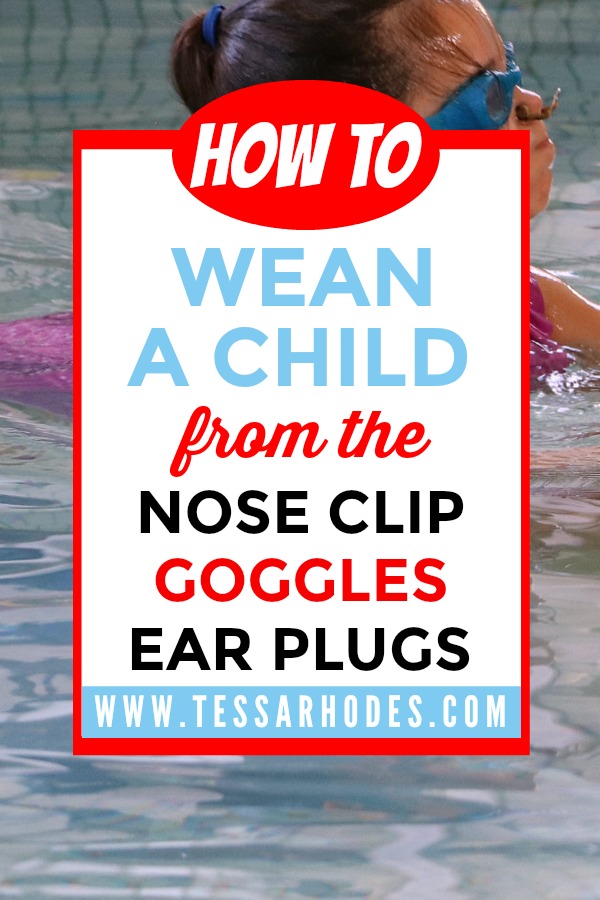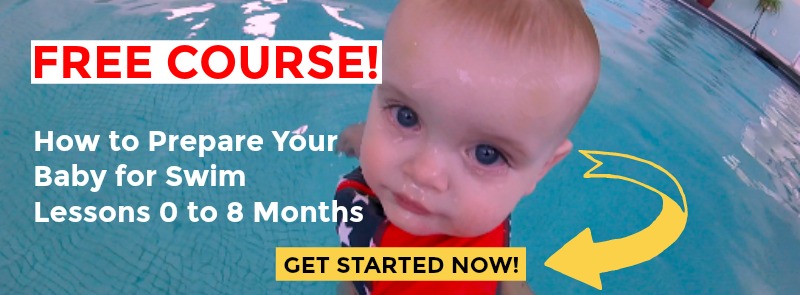Help your child eliminate the need for goggles, a nose clip, and ear protection.

Is your child comfortable in the shallow end of a swimming pool? Can he easily put his face in the water for at least ten seconds, front float for at least five seconds independently, back float for at least fifteen seconds unaided, roll and retrieve objects from the bottom?
If he can perform all of these skills with the aid of a nose clip, goggles, and/or ear protection, it’s time to wean him off these crutches.
If your child feels that he’s not ready to give up this protection yet, don’t force it (especially if he’s only four years old). But there’s no harm in a little encouragement.
Sometimes ending up in the water is out of our control. To avoid a panicked situation, your child must learn how to perform all of these skills without the added gear.
You can start the weaning process in a bathtub or on the steps of a swimming pool.
How to wean your child from the nose clip
Demonstrate this first. While sitting in a bathtub or on the steps of a swimming pool, hold your nose closed with your thumb and index finger.
Now take a breath and hold it (when demonstrating this, fill your cheeks with air. You can say, “look at my balloon face.”) put your face in the water, let go of your nose for a couple of seconds or more, hold your nose again, then take your face out of the water.
Now have your child try it with his “balloon face.” (If he’s not willing to try, these games might motivate him) Even if it’s just for a split second. As long as he doesn’t panic, he will probably be okay with this.
See if he can lengthen the time. Challenge him to do it for two or three or more seconds.
If water is going up his nose, have him blow bubbles with his nose or hum when his face is in the water. Humming will automatically cause the air to exit the nose.
Blowing bubbles with the nose
Blowing bubbles with the nose takes a little practice. As mentioned above, humming will automatically cause the air to exit the nose.
Try this above the water first. Have your child close his mouth and hum.
Make sure that he begins to hum before he puts his face in the water. Continue to hum while his face is in the water AKA blow bubbles with his nose and don’t stop humming until his face is safely out of the water.
Even though this seems like a simple exercise, I still see bubbles being produced from the mouths of some of my students, since they’re not closing their mouths tightly enough.
It’s a challenge for some, but many children can hold their breath or just blow bubbles with their mouth, not their nose and still keep their noses happy. There’s no one right way; it’s just a personal preference.
But ultimately learning how to blow bubbles with the nose is necessary when learning formal swimming strokes.
Once your child gets the hang of putting his face in the water without a nose clip, have him practice all of his newly acquired skills without the nose clip.
He may still find it to be a challenge to roll over without a nose clip. Even I get a little water up my nose sometimes when I roll over or swim on my back. There will be times where it just can’t be avoided.
Freedom from the goggles
Your child doesn’t have to give up goggles altogether. It is a good idea, however, to learn to be comfortable in the water without them.
It’s comforting to know that if your child ended up in the water without warning, that he wouldn’t panic.
In a bathtub or on the steps of a swimming pool, have your child practice putting his face in the water with his eyes closed, but without goggles.
When he’s ready, have him close his eyes, put his face in the water, then just open and close his eyes, like a blink. He’ll probably feel a slight stinging sensation, but it disappears soon after.
Encourage him to try it again and open his eyes for a couple of seconds, unless he doesn’t want to, then don’t force it. Just try it again another day and set goals to lengthen the time.
To be independent of the goggles will ultimately give him more freedom in the water. He’ll be able to enjoy a day of recreational swimming with family and friends and not be the least bit concerned about his eyes.
Goggles certainly have their place. In addition to being able to see more clearly underwater, some swim schools require that their students wear them.
Time to eliminate the ear protection
You might not even need to help your child with this. He may simply forget about it one day and start swimming without it. I’ve seen it happen with some of my students.
Let your child decide when he’s ready to give up the ear protection, whether it’s an ear swim cap (a swim cap that covers the ears), a swimming headband or even ear plugs.
Check in with him now and then to see if he’s willing to put an ear lobe in the water. If he is, that’s great.
You could encourage him to place one whole ear in the water with motivational games.
Have him hold on to the edge of the pool, turn his head to one side and lower it into the water. If he’s still happy, have him try the other ear. If he’s not happy, don’t force it. Suggest that he try again on another day.
If all goes well, encourage him to submerge his whole head. Most of my ear sensitive students only need ear protection when they swim or float on their back. They don’t like how the water tickles their ears.
One of my students helped me understand that for him, once his ears filled with water, he was okay. This discovery helped him realize that he no longer needed the ear protection.
There are no other positions in the water that have the same effect on the ears. Reassure your child that it’s okay to have water in his ears while swimming. It won’t hurt him. It goes away as soon as his head is out of the water.
How to prevent swimmer’s ear
- I start by emptying one of those little bottles of ear drying drops and replacing the contents with 1 Tablespoon of white vinegar and 1 Tablespoon of rubbing alcohol. I also reuse the same container over and over again.
- I administer 5 drops in each ear every time I get out of the pool. No need to lie down on each side for 5 minutes as you are required to do so with antibiotic ear drops for it to penetrate. Just 5 drops in each ear, and that’s it.
Where do we go from here?


Leave a Reply